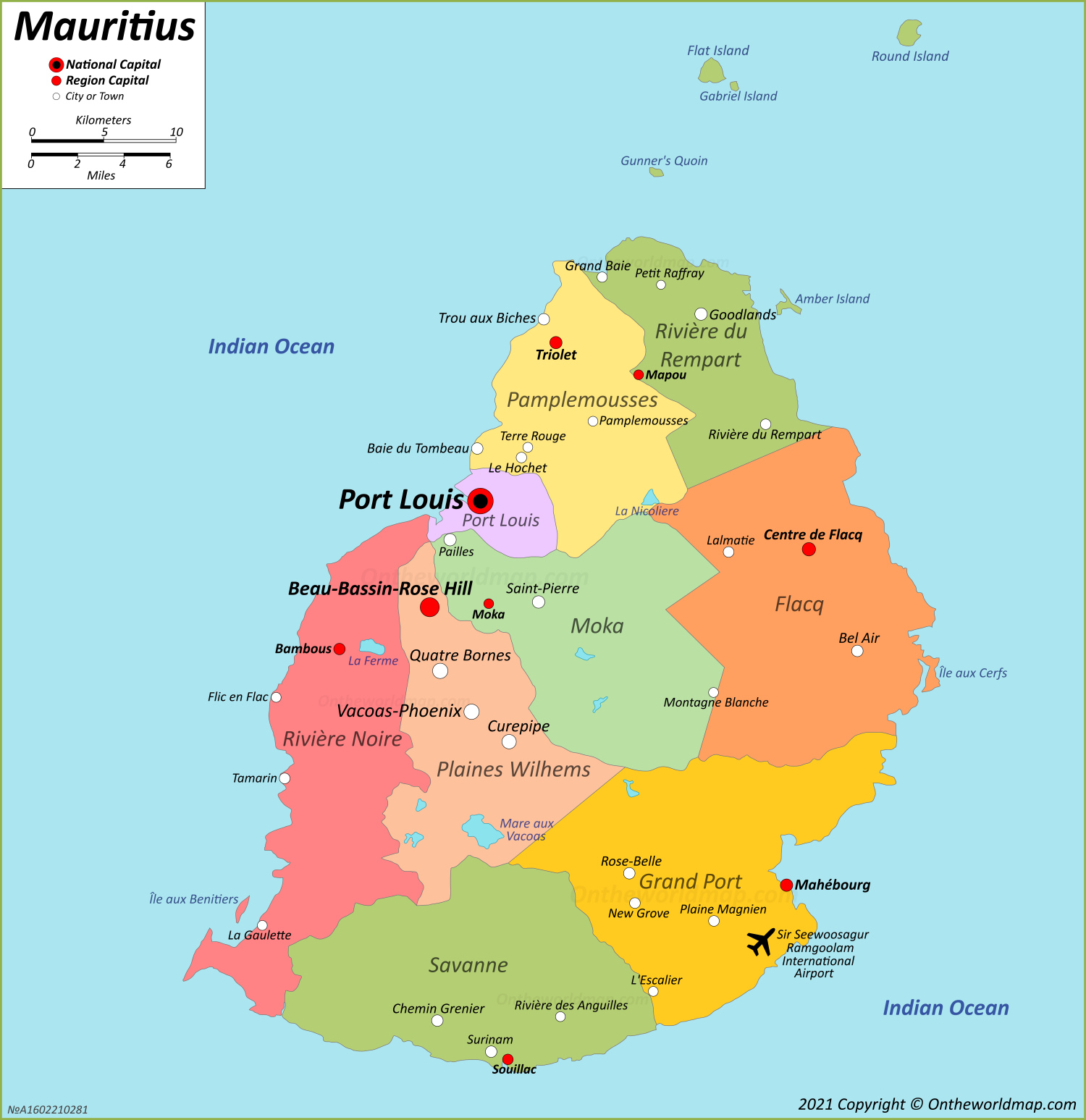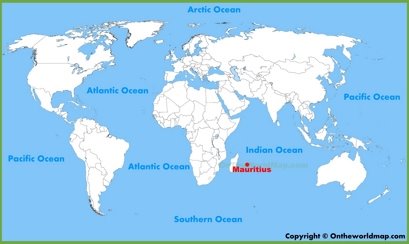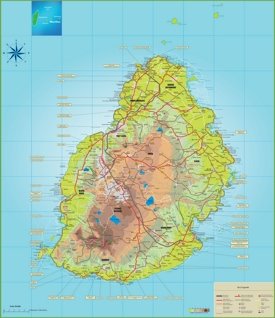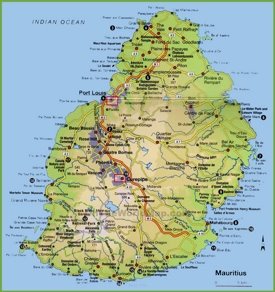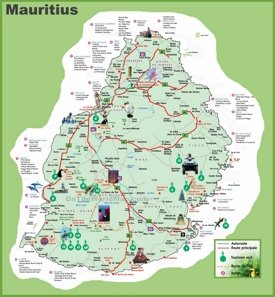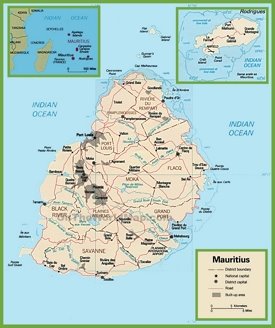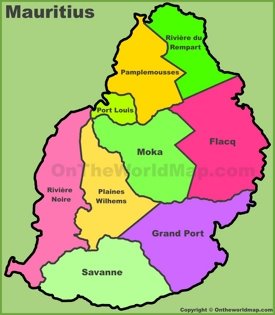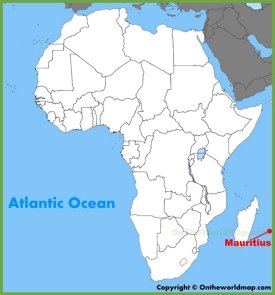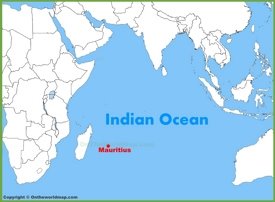Mauritius Map
Description:
This map shows islands, lakes, airport, region boundaries, regions, region capital cities, major cities and towns in Mauritius.
Size: 1500x1547px / 461 Kb
Author: Ontheworldmap.com
You may download, print or use the above map for educational, personal and non-commercial purposes. Attribution is required. For any website, blog, scientific research or e-book, you must place a hyperlink (to this page) with an attribution next to the image used.
Online Map of Mauritius
Detailed Maps of Mauritius
About Mauritius
Mauritius is an island nation in the Indian Ocean, located about 1,200 miles (2,000 kilometers) off the southeastern coast of the African continent. The country has an area of 790 square miles (2,040 square kilometers). Mauritius has no land borders with other nations due to its isolation. Reunion Island (a French overseas island) is located nearby. Recent estimates put the population of Mauritius at about 1.3 million.
Port Louis, the capital and largest city, serves as the economic and administrative center. Other notable towns include Beau Bassin-Rose Hill, Wacoas-Phoenix and Curepipe, which contribute significantly to the urban landscape.

The economy of Mauritius is based on tourism, textiles, sugar and financial services. The tourism sector plays a crucial role, attracting tourists with unspoiled beaches, luxury resorts and diverse marine life. Tourists often engage in activities such as snorkeling, diving, and deep-sea fishing, further strengthening the economy. In addition, the government continues to diversify the economy by promoting information technology and renewable energy.
Mauritius has a stable political environment, which contributes to its economic development. The country ranks high in terms of economic freedom and ease of doing business in the African context. The main languages of government and business are English and French, reflecting the country's colonial history.
The Facts:| Capital: | Port Louis |
| Area: | 790 sq mi (2,040 sq km) |
| Population (2019): | ~ 1,265,475 |
| Official language: | None (de jure). de facto: English and French. |
| Currency: | Mauritian rupee (MUR) |
| Driving side: | left |
| Calling code: | +230 |
| Internet TLD: | .mu |
| Time zone: | UTC+4 (MUT) |
| Gross domestic product 2024 (PPP): |
|
| Gross domestic product 2024 (nominal): |
|
Cities and Towns: Port Louis, Beau Bassin-Rose Hill, Curepipe, Quatre Bornes, Vacoas-Phoenix, Baie du Tombeau, Bel Air Rivière Sèche, Goodlands, Le Hochet, Saint Pierre, Triolet.
Districts of Mauritius: Flacq, Grand Port, Moka, Pamplemousses, Plaines Wilhems, Port Louis, Rivière du Rempart, Rivière Noire, Savanne.
Geography of Mauritius
Mauritius, located in the Indian Ocean, is characterized by a diverse geographical landscape. The island has a central plateau surrounded by mountain ranges and coastal plains. The highest peak, Piton de la Petite Rivière Noire, reaches an elevation of 2,717 feet (828 meters). The island's topography contributes to its diverse ecosystems, including forests, rivers, and coral reefs.
Mauritius has a tropical maritime climate characterized by two distinct seasons. Warm, humid summers last from November through April, with temperatures ranging from 75 to 91°F (24-33°C). Cool, dry winters last from May through October, with temperatures ranging between 61°F and 75°F (16°C-24°C). Cyclones can occur during the summer months, which affect weather conditions and sometimes cause significant damage.
The island is divided into several regions: the northern region, known for its beaches; the central plateau, where the urban centers are located; and the southern region, which contains rugged coastlines and nature reserves.
Brief History of Mauritius
The history of Mauritius reflects a succession of colonial influences and cultural developments. Arab navigators first discovered the island in the 10th century, but it remained uninhabited until the arrival of the Portuguese in the early 16th century. The Dutch established the first settlement in 1638, naming the island after Prince Maurice of Nassau, but abandoned it in 1710.
The French took control of the island in 1715, developing a thriving sugar economy. In 1810, the British captured Mauritius during the Napoleonic Wars and maintained control until the island's independence in 1968.
Throughout these periods, the island's population grew through the importation of enslaved Africans and indentured laborers from India, which shaped Mauritius' multicultural society.

